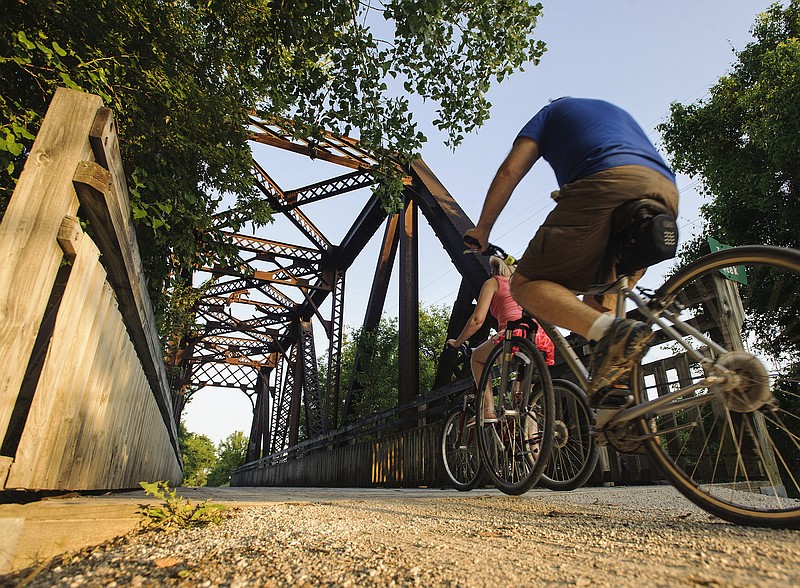Day and night, through the streets and on Katy Trail, Missouri residents are choosing to ride bicycles over cars for their preferred mode of travel.
Even in Jefferson City, there are more opportunities where cyclists can ride and enjoy the sights of the city. The 16th annual Katy Trail Ride last week allowed riders of all ages to ride the entire trail, making stops at towns such as Hartsburg and Hermann, said Bill Bryan, director of state parks.
The ride draws at least 350 visitors from all over the globe, Bryan said, and the 350 spots usually fill up within hours because many return or new cycling enthusiasts learn of the event.
Due to popular demand for a healthier lifestyle or necessity to save money for transportation, Jefferson City is starting to look into creating more options, according Sonny Sanders, senior transportation planner for the Capital Area Metropolitan Planning Organization (CAMPO).
Two years ago, CAMPO staff members approached their board of directors about including bicycle and pedestrian planning to help residents who either choose to ride or can't drive to work or around the city.
"Sometimes, owning a car is not possible, and more folks either walk, ride a bicycle, borrow a ride from someone, or take transit," Sanders said. "We're a tourist town. People come in, they get out and they like to wander around the streets and parks."
Cycle Depot owners Mark and Pam Allchorn have been in the cycling business for years. Mark Allchorn said when the couple moved from Hartsburg to Jefferson City, they found great success and have slowly watched Jefferson City evolve.
"I think (cycling) has grown, it certainly hasn't diminished in any way," Allchorn said. "We're adding to infrastructure instead of taking it away, which is always a good thing."
Cycling can be either a recreational or professional activity for Missourians. According to a U.S. Census Bureau survey, there are 2 million bicyclists in Missouri. Also, the National Household Travel survey show those bicyclists take 20 million bicycle trips each year.
A large number ride because it's their only means of transportation, Missouri Bicycle and Pedestrian Federation President Rachel Ruhlen said, and it's usually because it helps them save money when going to work or to improve their health.
Despite the large number of state residents interested in cycling, Ruhlen said there is still room for more infrastructure to be built for cyclists and pedestrians that connects all areas of Jefferson City and the rest of Missouri.
Without proper bike lanes or pedestrian-friendly infrastructure, it's difficult to safely maneuver through vehicular traffic, she said.
The Missouri Bicycle and Pedestrian Federation advocates for the needs of pedestrians and cyclists by meeting with state legislators, Missouri Department of Transportation and other state agencies.
"Not only do we talk to legislators, but we encourage our members to also contact and write letters to them," Ruhlen said.
MoDOT has been an incredible ally to the federation's cause and making roads safer for pedestrians and cyclists, Ruhlen said. One example is the Daniel Boone Bridge spanning the Missouri River between St. Charles and St. Louis counties. Started in 2013, the new eastbound bridge includs a bike/ped trail connecting the Monarch Levee Trail to the Katy Trail. The federation was glad to see the state begin a pedestrian-related project for its own interest, not the federation's, she said.
"I'm not sure what you could say is the one cause for it, but you can say that adding infrastructure to a city's cycling (community) and making it more accessible will be a draw to people, since they'll have places to ride," Ruhlen said.
Even though it's taken some time to build more cycle-friendly infrastructure, Allchorn said Jefferson City seems to be heading in the right direction.
"You see little bits of things, like a half-mile piece of trail, but then all of a sudden after four or five years, you look around and it's like, 'Hey, there are all these little bits of trail, and they've all been linked up,' and now we're looking at something that's quite significant," he said.

